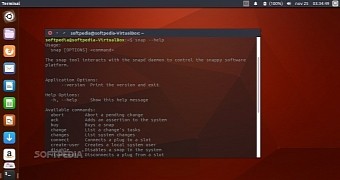Canonical's Snappy team is back from the extended Christmas and New Year's holidays, and they've recently announced the release of the Snapd 2.21 Snappy daemon through Michael Vogt, Synaptic and APT developer.
Marked as the first point release to the major Snapd 2.2 series, which introduced classic confinement support, Snapd 2.21's highlights include the new physical-memory-* and io-ports-control interfaces, enablement of the getsockopt interface by default everywhere, and support for installing classic confined Snaps from the Snappy Store.
Snapd 2.21 also improves alias handling with a new "snap aliases" command that would allow users to list available aliases and their current status, as well as auto-alias enhancements. Moreover, it improves the output of the "snap find" command when nothing is found and switches to a pure, Go-based gettext implementation.
The output of the "snap info" command was improved as well in the new Snapd version, with fixes for remote sizes and the tracked channel output, and users will now be able to use the Snapd Snappy daemon from the Core Snap. Other than that, the upower-observer interface received some minor improvements.
Coming soon to an Ubuntu distro near you
While the Snapd 2.21 source archive is already available for download from the usual places for those who fancy compiling software from sources, it will take a while before it lands in the stable repositories of your favorite Ubuntu release. At the moment of writing this article, it landed in the "proposed" repo.
If you have the "proposed" repository enabled, you can now install Snapd 2.21 in Ubuntu 14.04 LTS (Trusty Tahr), Ubuntu 16.04 LTS (Xenial Xerus), and Ubuntu 16.10 (Yakkety Yak). It's also available on the "candidate" channel of Ubuntu 17.04 (Zesty Zapus) development release for Core and Ubuntu Core Snaps.
On the other hand, those of you brave enough to test drive the new Snapd 2.21 stable release on their Ubuntu Core-powered devices need only to execute the "snap refresh --candidate core" command in a terminal emulator or virtual console. Rest assured that you'll update this story as soon as the new Snapd Snappy daemon version hits the stable Ubuntu Linux repositories.

 14 DAY TRIAL //
14 DAY TRIAL //